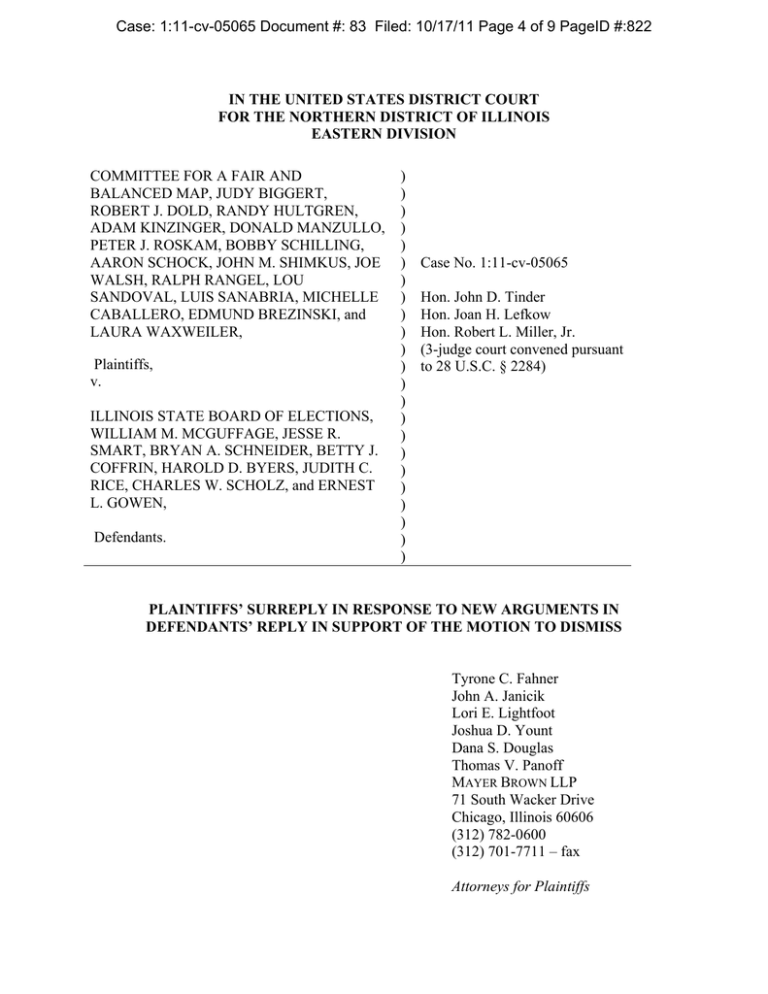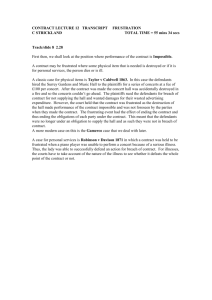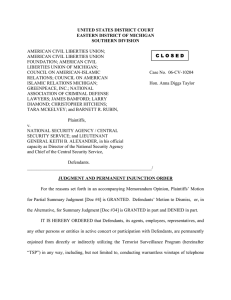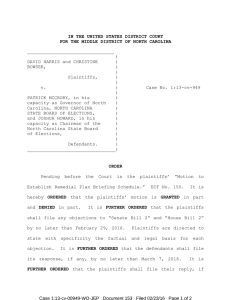COMMITTEE FOR A FAIR AND ) BALANCED MAP, JUDY BIGGERT,
advertisement

Case: 1:11-cv-05065 Document #: 83 Filed: 10/17/11 Page 4 of 9 PageID #:822 IN THE UNITED STATES DISTRICT COURT FOR THE NORTHERN DISTRICT OF ILLINOIS EASTERN DIVISION COMMITTEE FOR A FAIR AND BALANCED MAP, JUDY BIGGERT, ROBERT J. DOLD, RANDY HULTGREN, ADAM KINZINGER, DONALD MANZULLO, PETER J. ROSKAM, BOBBY SCHILLING, AARON SCHOCK, JOHN M. SHIMKUS, JOE WALSH, RALPH RANGEL, LOU SANDOVAL, LUIS SANABRIA, MICHELLE CABALLERO, EDMUND BREZINSKI, and LAURA WAXWEILER, Plaintiffs, v. ILLINOIS STATE BOARD OF ELECTIONS, WILLIAM M. MCGUFFAGE, JESSE R. SMART, BRYAN A. SCHNEIDER, BETTY J. COFFRIN, HAROLD D. BYERS, JUDITH C. RICE, CHARLES W. SCHOLZ, and ERNEST L. GOWEN, Defendants. ) ) ) ) ) ) Case No. 1:11-cv-05065 ) ) Hon. John D. Tinder ) Hon. Joan H. Lefkow ) Hon. Robert L. Miller, Jr. ) (3-judge court convened pursuant ) to 28 U.S.C. § 2284) ) ) ) ) ) ) ) ) ) ) ) PLAINTIFFS’ SURREPLY IN RESPONSE TO NEW ARGUMENTS IN DEFENDANTS’ REPLY IN SUPPORT OF THE MOTION TO DISMISS Tyrone C. Fahner John A. Janicik Lori E. Lightfoot Joshua D. Yount Dana S. Douglas Thomas V. Panoff MAYER BROWN LLP 71 South Wacker Drive Chicago, Illinois 60606 (312) 782-0600 (312) 701-7711 – fax Attorneys for Plaintiffs Case: 1:11-cv-05065 Document #: 83 Filed: 10/17/11 Page 5 of 9 PageID #:823 Defendants’ reply brief reaffirms the feebleness of their motion to dismiss, even making arguments that this Court effectively disposed of in its recent discovery order. See 10/12/11 Opinion and Order [Doc. #77] at 6 (“Proof of discriminatory intent is required for plaintiffs to prevail on their Fourteenth and Fifteenth Amendment racial discrimination claims” and “has also been found sufficient, though not necessary, to sustain a VRA claim”); id. at 8 (“Plaintiffs allege many of [the totality of the circumstance] factors in their Complaint.”); id. at 15-16 (“Plaintiffs raise profound questions about the legitimacy of the redistricting process and the viability of the 2011 Map.”). But the reply brief also offers two new arguments that Plaintiffs have not had the opportunity to address: First, as to Plaintiffs’ intentional discrimination claims (Counts I through III), Defendants now argue that the proportionality inquiry must focus on citizen voting age population, not voting age population. Second, as to Plaintiffs’ partisan gerrymander claims (Counts V and VI), Defendants invoke a recent decision from a federal district court in Texas that dismissed partisan gerrymander claims because the plaintiffs had not put forward an acceptable standard. In order to address these new arguments—which are both meritless— Plaintiffs hereby file this limited surreply. I. Defendants’ Argument Regarding Citizen Voting Age Population Is Meritless. Abandoning their opening brief’s ludicrous claim (at 6) that proportionality is a “district- specific” concept, Defendants now argue (at 5-6) that the Complaint improperly focuses on the gross disparity between Illinois’s 15.8% Latino voting age population and the 5.6% of majorityLatino districts in Illinois’s congressional redistricting plan. According to Defendants (at 6), the Complaint should instead have focused on “citizen voting-age population,” which Defendants now claim is “the ‘proper benchmark’ for measuring proportionality.” Defendants’ argument is absurd—and wrong. To begin with, it is remarkably untethered 1 Case: 1:11-cv-05065 Document #: 83 Filed: 10/17/11 Page 6 of 9 PageID #:824 from the standard that governs motions to dismiss. Defendants cannot plausibly claim that they lack notice of Plaintiffs’ claims simply because the Complaint uses voting age population (“VAP”) rather than citizen voting age population (“CVAP”). Regardless of the “proper benchmark” for one of a number of relevant factors, the Complaint “give[s] enough details about the subject-matter of the case to present a story that holds together” (Swanson v. Citibank, N.A., 614 F.3d 400, 404 (7th Cir. 2010)), which is all that it must do to survive a motion to dismiss. But the most fundamental problem with Defendants’ argument is that VAP—not CVAP—is the proper benchmark. “[A]pportionment is based on Census returns,” and all other “estimates about population . . . don’t matter” in redistricting challenges. Gonzalez v. City of Aurora, Illinois, 535 F.3d 594, 597 (7th Cir. 2008). Prior to the 2010 Census, each decennial Census included questions on citizenship, and each Census report contained CVAP numbers. See U.S. Census Bureau, Decennial Census – American FactFinder (noting that the 2000 Census included questions on citizenship)1; Gonzalez, 535 F.3d at 596 (listing CVAP figures from 2000 Census). The 2010 Census eliminated questions on citizenship. See Kerry Pickett, 2010 Census Lacks Citizenship Question, WASH. TIMES, Jan. 11, 2010. As a result, the 2010 Census does not report CVAP numbers; it reports only VAP numbers, making VAP the appropriate benchmark. To be sure, one may try to estimate CVAP. And Defendants’ expert appears to have done so by relying on “the American Community Survey sample.” See Expert Report of Allan J. Lichtman Re: Plaintiffs’ Allegations of Intentional Vote Dilution & Racial Predominance in Redistricting (Oct. 4, 2011) at 13. But, as the U.S. Census Bureau makes clear, “[those numbers] are not the 2010 Census population counts.” U.S. Census Bureau, American Community Survey, http://www.census.gov/acs/www/. Any estimates drawn from that sample therefore “don’t 1 http://factfinder.census.gov/jsp/saff/SAFFInfo.jsp?_lang=en&_sse=on&_content=sp4_ decennial.html&_title=Decennial+Census. 2 Case: 1:11-cv-05065 Document #: 83 Filed: 10/17/11 Page 7 of 9 PageID #:825 matter.” Gonzalez, 535 F.3d at 597. Because the 2010 Census does not contain CVAP numbers, VAP is the relevant benchmark. Thus, the disproportionality factor is satisfied. II. Nothing In Perez v. Texas Requires This Court To Dismiss Plaintiffs’ Partisan Gerrymandering Claims. Defendants never dispute that “a complaint need not contain legal theories” (Aaron v. Mahl, 550 F.3d 659, 666 (7th Cir. 2008)) or “do more than narrate a plausible claim for relief” (Morrison v. YTB Int’l, Inc., 649 F.3d 533, 538 (7th Cir. 2011)). But Defendants jettison (at 911) this well-established body of law in seeking dismissal of Plaintiffs’ partisan gerrymander claims based on the reading that the district court in Perez v. Texas (W.D. Tex. Sept. 2, 2011) (Ex. A to Defs’ Reply Br.) recently gave to Justice Kennedy’s concurrence in Vieth v. Jubelirer, 541 U.S. 267 (2004). The Perez court held that Justice Kennedy’s concurrence in Vieth required dismissal of partisan gerrymander claims where the plaintiffs did not articulate an acceptable standard for judging such claims. Speaking for only himself, Justice Kennedy took a similar position in Vieth. And the Perez court believed that aspect of Justice Kennedy’s concurrence was “controlling, because it is the ‘position taken by those Members [of the Court] who concurred in the judgment on the narrowest grounds.’” Slip op. at 21 (quoting Marks v. United States, 430 U.S. 188, 193 (1977)). Perez misapplies the “Marks test,” under which the so-called “narrowest” concurrence is treated as controlling. Subsequent to Marks, the Supreme Court has held that “[w]e think it not useful to pursue the Marks inquiry to the utmost logical possibility when it has so obviously baffled and divided the lower courts that have considered it.” Nichols v. United States, 511 U.S. 738, 745-46 (1994). Moreover, “[s]ince Marks, several members of the [Supreme] Court have 3 Case: 1:11-cv-05065 Document #: 83 Filed: 10/17/11 Page 8 of 9 PageID #:826 indicated that whenever a decision is fragmented such that no single opinion has the support of five Justices, lower courts should examine the plurality, concurring and dissenting opinions to extract the principles that a majority has embraced.” United States v. Johnson, 467 F.3d 56, 65 (1st Cir. 2006). Applying this correct standard to Vieth, controlling weight should not be given to Justice Kennedy’s view that complaints failing to articulate an acceptable standard should be dismissed. No other Justice in Vieth agreed that a complaint could be dismissed under Rule 12(b)(6) for failure to articulate a reliable legal standard. The plurality correctly noted that Justice Kennedy’s suggested disposition is “not legally available,” because “it is our job, not the plaintiffs’, to explicate the standard that makes the facts alleged by the plaintiffs adequate or inadequate to state a claim.” 541 U.S. at 301. The four dissenting Justices did not disagree with the plurality on that point, all voting against dismissal. Thus, what controls in Vieth is the eight-Justice majority that disagreed with Justice Kennedy’s rationale for dismissal.2 The Vieth concurrence would upend federal pleading standards and offers no reason why a partisan gerrymander claim should be treated differently from any other claim under the Rule 12(b)(6) analysis. Moreover, the Vieth concurrence has been superseded by Ashcroft v. Iqbal, in which Justice Kennedy wrote on behalf of a majority that “[w]hen there are well-pleaded factual allegations, a court should assume their veracity and then determine whether they plausibly give rise to an entitlement to relief.” 129 S. Ct. 1937, 1950 (2009). Under Iqbal, all that matters are a 2 LULAC v. Perry, 548 U.S. 399 (2006), also offers no support for Defendants. Both Perez (slip op. at 21) and Defendants (at 10) quote from Part II.B. of Justice Kennedy’s opinion in LULAC, but—once more—no other Justice joined Justice Kennedy on that point. Moreover, the passage in question simply stated that “a successful claim attempting to identify unconstitutional acts of partisan gerrymandering must . . . show a burden, as measured by a reliable standard, on the complainants’ representational rights.” Id. at 418. Plaintiffs’ Complaint satisfies that test. The Complaint alleges facts that “show a burden” on Plaintiffs’ “representational rights” under any “reliable standard” that this Court might adopt. 4 Case: 1:11-cv-05065 Document #: 83 Filed: 10/17/11 Page 9 of 9 PageID #:827 complaint’s well-pleaded factual allegations; it is the court’s role to determine whether those factual allegations “give rise to an entitlement to relief.” Id. Perez is also distinguishable. In Perez, the plaintiffs “were given an opportunity” to “identif[y]” a justiciable standard. Slip op. at 21. Here, Plaintiffs have not had that opportunity. The sole dispute at this point is whether the Complaint must “contain legal theories.” See Aaron, 550 F.3d at 666. Should this Court conclude that Plaintiffs’ Complaint must articulate a justiciable standard for partisan gerrymanders, then Plaintiffs should be given leave to file an amended pleading that offers such a standard. CONCLUSION The Court should deny Defendants’ motion to dismiss. Dated: October 17, 2011 Respectfully submitted, /s/ Lori E. Lightfoot Tyrone C. Fahner John A. Janicik Lori E. Lightfoot Joshua D. Yount Dana S. Douglas Thomas V. Panoff MAYER BROWN LLP 71 South Wacker Drive Chicago, Illinois 60606 (312) 782-0600 (312) 701-7711 – fax Attorneys for Plaintiff 5



